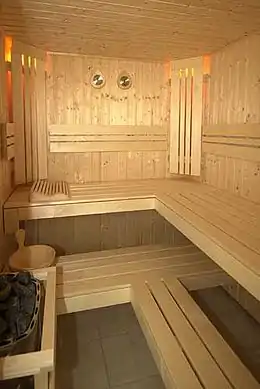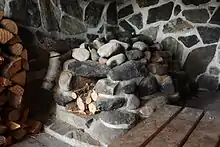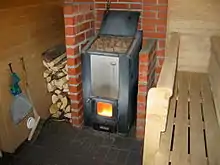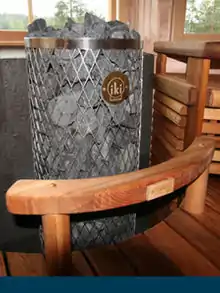Finnish sauna
The Finnish sauna (Swedish: bastu) is a substantial part of Finnish culture.[2] It was inscribed on the UNESCO Intangible Cultural Heritage Lists at the December 17, 2020 meeting of the UNESCO Intergovernmental Committee for the Safeguarding of the Intangible Cultural Heritage.[3] As authorized by the state, the Finnish Heritage Agency commits, together with Finnish sauna communities and promoters of the sauna culture, to safeguard the vitality of the sauna tradition and to highlight its importance as part of customs and wellbeing.[4][5]
| Sauna culture in Finland[1] Finnish: saunakulttuuri Suomessa[1] Swedish: bastukultur i Finland[1] Northern Sami: sávdnjekultuvra Suomas[1] | |
|---|---|
 | |
| Country | Finland |
| Criteria | Social practices |
| Reference | 01596 |
| Region | Europe and North America |
| Inscription history | |
| Inscription | 2020 (15th session) |
| List | Representative |
 A typical modern Finnish sauna | |
Origins of the sauna
The sauna in Finland is an old phenomenon and its roots are difficult to trace, but its earliest versions are believed to be from 7000 BC. Bath houses were recorded in Europe during the same time period, but Finnish bathing habits were poorly documented for most of history. One of the first written mentions of what is believed to be the sauna customs of the forefathers of the Finns was written by Nestor the Chronicler in 1112. He told of "hot wooden saunas in which naked bathers beat themselves with branches and finally pour cold water over themselves".
During the Reformation in Scandinavia the popularity of saunas expanded to other countries because the European bath houses were being destroyed.
One reason the sauna culture has always flourished in Finland has been because of the versatility of the sauna. When people were moving, the first thing they did was to build a sauna. Finns would use the sauna to live in, eat, address matters of hygiene, and, most importantly, give birth in an almost sterile environment. Unlike many other, more densely populated places in Europe, the availability of wood needed to build and warm the sauna has never been an issue. Another reason for its popularity is that in such a cold climate, the sauna allows people warmth for at least a short period of time. However, it is just as popular in the summer as in the winter.
Finnish sauna customs
Saunas are an integral part of the way of life in Finland. They are found on the shores of Finland's numerous lakes, in private apartments, corporate headquarters, at the Parliament House and even at the depth of 1,400 metres (4,600 ft) in Pyhäsalmi Mine. The sauna is an important part of the national identity[7] and those who have the opportunity usually take a sauna at least once a week. The traditional sauna day is Saturday.[8]
.jpg.webp)
The sauna tradition is so strong that whenever Finns go abroad, they relish the chance to have a good sauna: even the Finnish Church in Rotherhithe, London, has its own sauna. Finnish soldiers on peacekeeping missions are famous for their saunas; even on the UNMEE mission in Eritrea, a sauna was one of the first buildings to be erected.[9] A Second World War-era Finnish military field manual states that a break of eight hours is all that is required for a battalion to build saunas, warm them and bathe in them. Saunas, even in the military, are strictly egalitarian places: no titles or hierarchies are used in the sauna.
Taking a sauna begins with having a wash (usually a shower), followed by a sit in the sauna room, the room being typically warmed to 80–110 °C (176–230 °F). Water is thrown on the hot stones topping the kiuas, a special stove used to warm up the sauna. This produces great amounts of wet steam, known as löyly, increasing the moisture and the apparent temperature within the sauna. Only the word löyly is used for this particular type of steam (the Finnish word höyry ('steam, vapour') is never used for it except in a scientific sense. Equivalents for löyly can be found in the Finnic languages such as the Karelian löyly, the Estonian leil, the Votic leülü, the Veps l'öl' and the Livonian löul. Its original sense signified 'spirit, breath, soul' and this is still seen in the Uralic languages--for example, the Udmurt lul, the Komi lol, the Mansi läl ('life'), the Khanty lil and the Hungarian lélek.[10]
Occasionally one uses a bunch of leafy, fragrant silver birch called a vihta (vasta in Eastern Finland) to gently beat oneself. This has a relaxing effect on the muscles and also helps to soothe the irritation from mosquito bites. When the heat begins to feel uncomfortable it is customary to jump into a lake, sea, or a swimming pool, or to have a shower. In the winter, rolling in the snow or even swimming in a hole cut in lake ice, an avanto, is sometimes used as a substitute. Often after the sauna it is a custom to sit down in the dressing room or on the porch of the sauna to enjoy a sausage, along with beer or soft drinks.
After cooling down from the first bath, one goes back into the hot room and begins the cycle again. The number and duration of hot room-cooling down cycles varies from person to person based on personal preference. Usually one takes at least two or three cycles, lasting between 30 minutes to two hours. In Finland's numerous summer cottages bathing might go on well into the night. This is especially true in the summer when there's virtually no darkness at night. The sauna session itself is finished off with a thorough wash.
For someone brought up in Finland, the rules are instinctive but they are difficult to put into words. Depending on the size, composition, relationships, and the age structure of the group three basic patterns can emerge: Everyone can go to the sauna at the same time, men and women may take a sauna separately, or each family can go to sauna separately. Mixed saunas with non-family members are most common with younger adults, and are quite rare for older people or on more formal occasions. It is common for teenagers to stop going to sauna with their parents at some point.
In the sauna it is a faux pas to wear clothing in the hot room, although it is acceptable to sit on a small towel or pefletti, a disposable tissue designed to endure heat and humidity (it can be mandatory in a public sauna, such as at a public swimming pool). While cooling off it is common to wrap a towel around the body. Although mixed saunas are quite common, for a typical Finn the sauna is, with few exceptions, a strictly non-sexual place. In Finland a "sauna" means only a sauna, not a brothel, sex club, or such. In public saunas, swimsuits are banned from the hot room for health reasons: in many indoor swimming pools, chlorine is added to the water for hygiene reasons; if swimwear used in such water is brought to the hot room, the chlorine will vaporize and cause breathing problems for people with asthma or allergies.
In private homes or summer residences, the sauna is usually warmed to honor the guest and refusal may be more difficult. However, Finns will not typically be very offended if their guest declines. This is particularly common if going to sauna would require a lot of effort from the guest (such as re-applying complex make-up afterwards), socially inconvenient (feeling uncomfortable about nudity and/or a mixed-sex sauna), or otherwise inconvenient (should the guest not have a change of clothes or if the sauna's going to take place late at night, et cetera).
Types of sauna



Many different types of sauna can be found in Finland. They can be classified either by the sauna building itself or by what kind of stove it uses.[11]
The main division of saunas is between once warmed and continuously warmed stoves. All smoke saunas are once warmed, but there are also other type of ovens that are once warmed.
Once warmed stoves have larger amount of stones that are warmed up before the bathing. This can be done by burning wood, with or without chimney, oil, wood pellets, or natural gas. Continuously warmed stoves have lower amount of stones that are heated during the bathing. The warming can be done burning wood, oil or natural gas, or electrically.
The temperature in Finnish saunas is 80 to 110 °C (176 to 230 °F), usually 80–90 °C (176–194 °F), and is kept clearly above the dewpoint despite the vaporization of löyly water, so that visible condensation of steam does not occur as in a Turkish sauna.
Smoke sauna
The savusauna (smoke sauna) does not have a chimney and thus as wood is burned smoke fills the room. After the sauna reaches the appropriate temperature, the fire is extinguished and the room is ventilated. Given the construction of the room, the sauna retains sufficient heat for the duration of use. Although smoke saunas are considered a more traditional type, there has been a significant increase in construction in recent years.[12] However, due to the amount of effort and time required to operate them -- heating can take most of a day -- they are not likely to replace most regular saunas.[13]
Smoke saunas are still extant not only in Finland but also in Estonia, Latvia, and Lithuania. They are considered to be cheap, simple to build, and durable (if measures of fire prevention are taken while building the sauna). The longevity is warranted by disinfectant features of smoke.
One specific and rarely seen curiosity is use of a wood pellet burner to heat a smoke sauna stove, typically the actual burner installed into a room adjacent to the actual sauna room and the kiuas. A wood pellet burner, quite similar to an oil burner, is then used to heat a smoke sauna stove - practically a big pile of rocks. As the burning process is much cleaner than with a conventional smoke stove the smoke aroma is much less pungent and soothy, while the moisture produced by the burning the pellets makes the air more pleasant than with continuously warmed stoves.
Wood stove sauna
The wood stove sauna is the most common type of sauna outside of the city areas, where the electric sauna is more common. The metal stove with stones on top (kiuas) is heated with birch wood fire, and this heats the sauna room to the required temperature. If birch wood is not available any other wood will do, but well dried birch wood is preferred because of its good quality and smell, and long lasting burn. The important thing is to have a good löyly, that is when the stones are hot enough to evaporate the water thrown on them into steam that rises to the bathers. The bather in every type of sauna sits on a high bench near the ceiling where the hot steam reaches them quickly.
Electric sauna
In city apartments, and in most public saunas, an electric sauna stove (kiuas) is used, as it does not require wood to burn. They are very simple to prepare, only a press of a button will do. They usually have stones to retain heat, like their smoke sauna and wood stove counterparts, but sometimes even a large slab of stone is used to give the same effect as you throw water on it. Most apartment buildings in Finland include at least this type of sauna, or there is one for use by the occupants of a building, with dedicated hours for use for communal men's and women's sauna, and special hours for those who have requested apartment specific hours. Most Finns prefer a wood stove sauna to an electric sauna.
Mobile saunas

Scouts and various other youth organizations often have portable tent saunas. Saunas have been built into cars, buses, car trailers, tractor trailers or even bicycles and boats.[14] In Finland, there are companies that rent mobile saunas,[15] and an annual mobile sauna event in Teuva.[16]
References
- Terho, Sampo (25 March 2019). "Nomination file No. 01596 for inscription in 2020 on the Representative List of the Intangible Cultural Heritage of Humanity" (docx). UNESCO. Retrieved 31 December 2020.
- Belinda Jackson (14 February 2020). "Finnish sauna rules: Five things you need to know". Stuff.co.nz. Retrieved 14 February 2020.
- "Saunaperinne Suomesta valittiin Unescon aineettoman kulttuuriperinnön luetteloon" (in Finnish). Museovirasto. Retrieved 21 December 2020.
- "Sauna culture in Finland". UNESCO. Retrieved 18 December 2020.
- "Finnish sauna culture steams up UNESCO Heritage List". YLE. 17 December 2020. Retrieved 18 December 2020.
- "Sauna". Merriam-Webster. Retrieved 18 December 2020.
- Valtakari, P.: Finnish Sauna Culture - Not Just a Cliché. The Finnish Sauna Society.
- Korhonen, N.: The sauna - a sacred place. Universitas Helsingiensis, 4/1998, Helsinki University, Helsinki.
- Aurén, V.: Barettiyhdistyksiltä Eritrean Sacristin kirjat (Finnish). Finnish Peacekeepers.
- Häkkinen, Kaisa (2005) [2004]. Nykysuomen etymologinen sanakirja (in Finnish). WSOY. p. 657. ISBN 951-0-27108-X.
- "Development of the Finnish sauna". Suomen Saunaseura ry. Retrieved 10 July 2012.
- "Sauna in Finland today". Suomen Saunaseura ry. Retrieved 10 July 2012.
- "Smoke sauna". Suomen Saunaseura ry. Archived from the original on 31 October 2009. Retrieved 28 April 2010.
- "Tässä ovat Kaunein kesäsauna -kilpailun finalistit - äänestä suosikkiasi! | Minun kotini". Iltalehti.fi. Retrieved 17 November 2016.
- "Archived copy". Archived from the original on 19 December 2011. Retrieved 24 February 2013.CS1 maint: archived copy as title (link)
- "Teuvan sauna-ajot - Etusivu". Sauna-ajot.com. Retrieved 17 November 2016.
External links
| Wikimedia Commons has media related to Saunas in Finland. |


